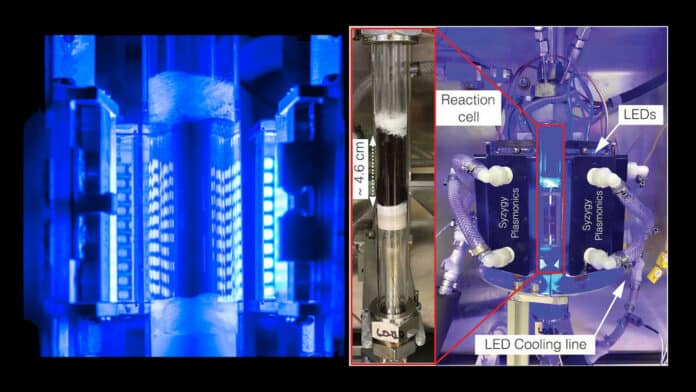Catalysts based on platinum group metals have been a significant focus of the chemical industry for decades. A group from Princeton University‘s Andlinger Center for Energy and the Environment, Syzygy Plasmonics Inc., and Rice University’s Laboratory for Nanophotonics developed a scalable catalyst that requires only light to transform ammonia into clean-burning hydrogen fuel.
The new catalyst splits these molecules into nitrogen gas, which makes up most of Earth’s atmosphere, and hydrogen gas, a clean-burning fuel. Additionally, it doesn’t require heat as conventional catalysts do. Instead, it obtains power from light sources, such as sunlight or energy-efficient LEDs.
Chemical makers have profited from the fact that temperature generally accelerates chemical reactions by administering heat on an industrial scale for more than a century. A significant carbon footprint is left behind when fossil fuels are burned to raise the temperature of massive reaction vessels by hundreds or thousands of degrees. Thermocatalysts are materials that do not react but accelerate processes when heated to high temperatures, and chemical producers spend billions of dollars annually on them.
Study co-author Naomi Halas of Rice said, “Transition metals like iron are typically poor thermocatalysts. This work shows they can be efficient plasmonic photocatalysts. It demonstrates that photocatalysis can efficiently perform with inexpensive LED photon sources.”
“This discovery paves the way for sustainable, low-cost hydrogen that could be produced locally rather than in massive centralized plants.”
Platinum and other closely related precious metals like palladium, rhodium, and ruthenium are used to make the best thermocatalysts. Years were spent by Halas and Nordlander creating plasmonic, or light-activated, metal nanoparticles. The best are frequently created using precious metals like gold and silver.
Halas, Nordlander, their students, and collaborators have worked for years to find non-precious metal alternatives for both the energy-harvesting and reaction-speeding halves of antenna reactors. The new study is a culmination of that work. In it, Halas, Nordlander, Rice alumnus Hossein Robatjazi, Princeton engineer and physical chemist Emily Carter, and others show that antenna-reactor particles made of copper and iron are highly efficient at converting ammonia. The copper, an energy-harvesting piece of the particles, capture energy from visible light.
Robatjazi said, “In the absence of light, the copper-iron catalyst exhibited about 300 times lower reactivity than copper-ruthenium catalysts, which is not surprising given that ruthenium is a better thermocatalyst for this reaction. Under illumination, the copper-iron showed efficiencies and reactivities similar to and comparable with copper-ruthenium.”
Syzygy has licensed Rice’s antenna-reactor technology, and the study included scaled-up tests of the catalyst in the company’s commercially available LED-powered reactors. In laboratory tests at Rice, the copper-iron catalysts had been illuminated with lasers. The Syzygy tests showed the catalysts retained their efficiency under LED illumination and at a scale 500 times larger than the lab setup.
Halas said, “This is the first report in the scientific literature to show that LED photocatalysis can produce gram-scale quantities of hydrogen gas from ammonia. This opens the door to entirely replace precious metals in plasmonic photocatalysis.”
Carter added, “Given their potential for significantly reducing chemical sector carbon emissions, plasmonic antenna-reactor photocatalysts are worthy of further study. “These results are a great motivator. They suggest it is likely that other combinations of abundant metals could be used as cost-effective catalysts for a wide range of chemical reactions.”
Journal Reference:
- Yogao Yuan et al. Earth-abundant photocatalyst for H2 generation from NH3 with light-emitting diode illumination. Science. DOI: 10.1126/science.abn5
